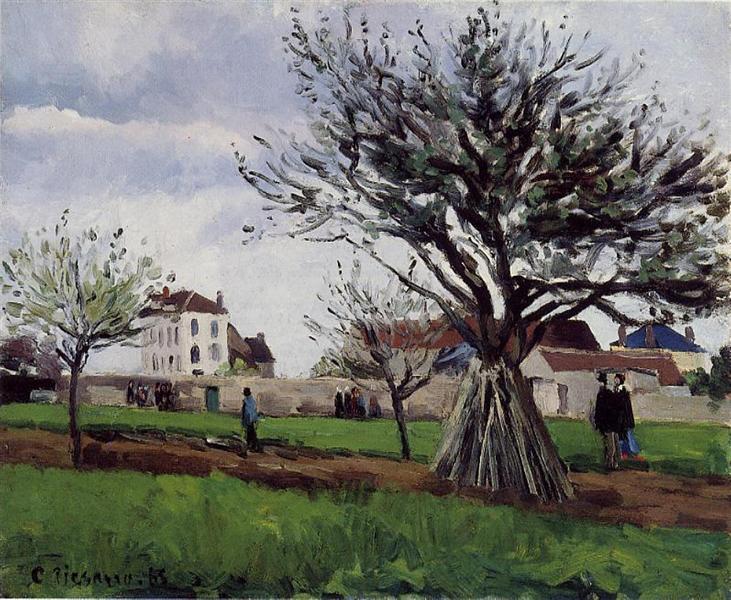Description
Camille Pissarro's Apple Trees at Pontoise, painted in 1868, is an exquisite representation of the artist's defining Impressionist style, masterfully capturing the everyday beauty of nature. Upon viewing this painting, the viewer is immediately immersed in a serene landscape that exudes an atmosphere of rural tranquility. In this work, Pissarro transports us to the surroundings of Pontoise, a place near Paris that was not only his home, but also a constant source of inspiration.
The composition of the painting is meticulously resolved, with the apple trees playing a central role, anchoring the scene with their robust and lively presence. The diagonal lines of the branches, which extend into the space of the painting, generate a sense of movement and organicity, leading the viewer's gaze across the pictorial surface. In the foreground, a group of trees can be seen with leaves in full bloom; the vibrant green colours and touches of white suggested by the apple blossoms provide a luminosity that is essential to Pissarro's work.
The palette used by the artist is characterized by a harmonious use of tones. The fresh greens, which dominate the upper part of the work, are combined with the earthy browns of the earth, where shadows are hinted at, giving depth to the composition. The loose and energetic brushstrokes, characteristic of Impressionism, contribute to the feeling of immediacy, as if the moment of the painting were captured in a fleeting moment of daylight.
Throughout the work, the interplay between light and colour is central, and sunlight can be seen playing across the leaves and branches, creating a kaleidoscope of hues that give the work a vibrant vitality. This focus on light aligns closely with the Impressionist aesthetic, a movement that Pissarro helped define and promote through his own practice and his interaction with other contemporary artists.
There are no prominent human figures in the painting, a trait that Pissarro adopted in several of his works to emphasize the connection between humans and nature. However, the remoteness and a slight hint of roads and cultivated areas suggest the presence of an active rural life, while also underlining a sense of harmony between the natural landscape and agricultural work. This absence or minimal inclusion of human figures allows the surroundings to speak for themselves, a reflection of agricultural life that is a constant in many of his later works.
“Apple Trees at Pontoise” can also be contextualized within Pissarro’s broader exploration of tree symbolism. Throughout his career, trees have functioned not only as visual subjects but as symbols of life and renewal, while encapsulating his longing for a return to simplicity in a rapidly modernizing world. The tree, in this sense, becomes a motif of introspection; a reflective parallel to Pissarro’s own life as an artist and observer of his surroundings.
Ultimately, this work stands as a significant example of the development of Impressionism and Pissarro’s personal evolution as a pioneer of the style. Reflecting his dedication to capturing not just the image, but the essence of a time and place, Apple Trees at Pontoise stands as one of the master’s many contributions that continue to resonate in the contemporary art world. With its faithful depiction of the beauty of the everyday, Pissarro reminds us of the importance of stopping and appreciating the proliferation of life around us—a message that remains as relevant today as it was in the year it was painted.
KUADROS ©, a famous painting on your wall.
Hand-made oil painting reproductions, with the quality of professional artists and the distinctive seal of KUADROS ©.
Painting reproduction service with satisfaction guarantee. If you are not completely satisfied with the replica of your painting, we will refund 100% of your money.

